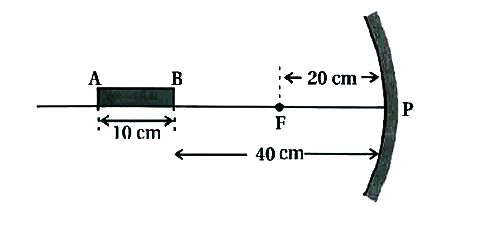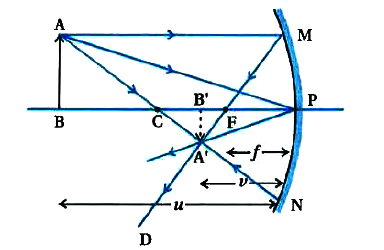Answer the following questions:
(a) The angle subtended at the eye by an object is equal to the angle subtended at the eye by the virtual image produced by a magnifying glass. In what sense then does a magnifying glass provide angular magnification? Solution in Gujrati
The angular dimension of image is equal to the angular dimension of object even if the absolute dimension is greater than that of object. Magnifier helps as following. By its help only, object can be placed nearer. Without its help object cannot be placed nearer than 25 cm. The angular dimension of object placed nearer is greater than that placed at 25 cm. In such a way, angular magnification can be obtained.
Topper's Solved these Questions
- RAY OPTICS AND OPTICAL INSTRUMENTSBOOK - KUMAR PRAKASHANCHAPTER - RAY OPTICS AND OPTICAL INSTRUMENTSEXERCISE - SECTION-B (NUMERICALS)(NUMERICAL FROM .DARPAN. BASED ON TEXTBOOK )
12 Videos
- RAY OPTICS AND OPTICAL INSTRUMENTSBOOK - KUMAR PRAKASHANCHAPTER - RAY OPTICS AND OPTICAL INSTRUMENTSEXERCISE - SECTION-C (NCERT EXEMPLAR SOLUTION) (MULTIPLE CHOICE QUESTIONS (MCQs))
16 Videos
- RAY OPTICS AND OPTICAL INSTRUMENTSBOOK - KUMAR PRAKASHANCHAPTER - RAY OPTICS AND OPTICAL INSTRUMENTSEXERCISE - SECTION-B (NUMERICALS)(NUMERICAL FROM TEXTUAL ILLUSTRATIONS)
17 Videos
- MOVING CHARGES AND MAGNETISMBOOK - KUMAR PRAKASHANCHAPTER - MOVING CHARGES AND MAGNETISMEXERCISE - SECTION D (MCQs ASKED IN COMPETITIVE EXAMS)
34 Videos
- SAMPLE QUESTION PAPER BOOK - KUMAR PRAKASHANCHAPTER - SAMPLE QUESTION PAPER EXERCISE - PART-B SECTION-C
5 Videos
Similar Questions
As shown in the figure, a thin rod AB of length 10 cm is placed on the principal axis of a concave mirror such that it.s end B is at a distance of 40 cm from the mirror. If the focal length of the mirror is 20 cm, find the length of the image of the rod

View SolutionA ray of light incident at an angle θ on a refracting face of a prism emerges from the other face normally. If the angle of the prism is 5∘ and the prism is made of a material of refractive index 1.5, the angle of incidence is
View SolutionSuppose that the lower half of the concave mirror.s reflecting surface as shown in figure is covered with an opaque (non-reflective) material. What effect will this have on the image of an object placed in front of the mirror ?

View SolutionElectric charge Q having mass M moves on a circular path of radius R with velocity →v, perpendicular to uniform magnetic field B. When a particle completes one revolution, work done by the field is _______
View SolutionTwo charges –q and +q are located at points (0, 0, –a) and (0, 0, a), respectively.
(a) What is the electrostatic potential at the points (0, 0, z) and (x, y, 0) ?
(b) Obtain the dependence of potential on the distance r of a point from the origin when r/a>>1 .
(c) How much work is done in moving a small test charge from the point (5,0,0) to (–7,0,0) along the x-axis? Does the answer change if the path of the test charge between the same points is not along the x-axis?
View SolutionAnswer the following questions : (a) The angle subtended at the eye by an object is equal to the angle subtended at the eye the virtual image produced by a magnifying glass. In what sense then does a magnifying glass provided angular magnification ? (b) In viewing through a magnifying glass, one usually positions one's eye very close to the lens. Does angular magnification change if the eye is moved back ? ( c) Magnifying power of a simple a convex lens of smaller and smaller focal length and achieving greater and greater magnifying power ? (d) Why must both the objective and eye piece of a compound microscope have a short focal lengths ? (e) when viewing through a compound microscope, our eyes should be positioned not on the eye piece, but a short distance away from it for best veiwing, why ? How much should be that short distance between the eye and eye piece ?
View Solutiona) The anlge subtended at the eye by an object is equal to the angle subtended at the eye by the virtual image produced by a magnifying glass. In what sense then does a magnifying glass provide angular magnifications?
b) in viewing through a magnifying glass, one usually positions one's eyes very close to the lens. Does angular magnification change if the eye is moved back?
c) magnifying power of a simple microscopes is inversely proportional to the focal length of the lens. What then stops us from using a convex lens of smaller and smaller focal length and achieving greater and greater magnifying power?
d) Why must both the objective and the eyepiece of a compound microscope have short focal lengths?
e) When viewing through a compound microscope, our eyes should be positioned not on the eyepiece but a short distance away from it fot best veiwing. Why? How much should be that short distance between the eye and eyepiece?
View Solutiona) The anlge subtended at the eye by an object is equal to the angle subtended at the eye by the virtual image produced by a magnifying glass. In what sense then does a magnifying glass provide angular magnifications? b) In viewing through a magnifying glass, one usually positions one's eyes very close to the lens. Does angular magnification change if the eye is moved back? c) Magnifying power of a simple microscopes is inversely proportional to the focal length of the lens. What then stops us from using a convex lens of smaller and smaller focal length and achieving greater and greater magnifying power? d) Why must both the objective and the eyepiece of a compound microscope have short focal lengths? e) When viewing through a compound microscope, our eyes should be positioned not on the eyepiece but a short distance away from it fot best veiwing. Why? How much should be that short distance between the eye and eyepiece?
View Solutionनिम्नलिखित प्रश्नो के उत्तर दीजिए : (a) किसी वस्तु द्वारा नेत्र पर अंतरित कोण आवर्धन लेंस द्वारा उत्पन्न आभासी प्रतिबिम्ब द्वारा नेत्र पर अंतरित कोण के बराबर होता है । तब फिर किन अर्थो में कोई आवर्धक लेंस कोणीय आवर्धन प्रदान करता है ? (b) किसी आवर्धक लेंस से देखते समय प्रेक्षक अपने नेत्र को लेंस से अत्यधिक सटाकर रखता है । यदि प्रेक्षण अपने नेत्र को पीछे ले जाए तो क्या कोणीय आवर्धन परिवर्तित हो जाएगा ? (c ) किसी सरल सूक्ष्मदर्शी की आवर्धन - क्षमता उसकी फोकस - दूरी के व्युत्क्रमानुपाती होती है । तब हमें अधिकाधिक आवर्धन - क्षमता प्राप्त करने के लिए कम से कम फोकस दूरी के उत्तल लेंस का उपयोग करने से कौन रोकता है ? (d) किसी संयुक्त सूक्ष्मदर्शी के अभिदृश्यक लेंस तथा नेत्रिका लेंस दोनों ही की फोकस - दूरी कम क्यों होनी चाहिए ? (e) संयुक्त सूक्ष्मदर्शी द्वारा देखते समय सर्वोत्तम दर्शन के लिए हमारे नेत्र, नेत्रिका पर स्थित न होकर उससे कुछ दूरी पर होने चाहिए क्यों ? नेत्र तथा नेत्रिका के बीच की यह अल्प दूरी कितनी होनी चाहिए ?
View Solutionएक आवर्धक काँच (magnifying glass) से किसी वस्तु को देखने के लिए सामान्यतः आँख को लेस के बहुत निकट रखा जाता है | जब आँख को पीछे की और हटाया जाता है तो क्या कोणीय आवर्धन हो जाता है ?
View Solutionकिसी वस्तु द्वारा नेत्र पर अंतरित कोण आवर्धक लेंस द्वारा उत्पन्न आभासी प्रतिबिम्ब द्वारा नेत्र पर अंतरित कोण बराबर होता है। तब फिर किन अर्थों में कोई आवर्धक लेंस कोणीय आवर्धन प्रदान करता है ?
View Solutiona) The angle subtended at the eye by an object is equal to the angle subtended at the eye by the virtual image produced by a magnifying glass. In what sense then does a magnifying glass provide angular magnification ?
View Solutionकिसी वस्तु द्वारा नेत्र पर अंतरित कोण आवर्धक लेंस द्वारा उत्पन्न आभासी प्रतिबिंब द्वारा नेत्र पर अंतरित कोण के बराबर होता है | तब फिर किन अर्थो में कोई आवर्धक लेंस कोणीय आवर्धन प्रदान करता है ?
View SolutionThe angle subtended at the eye by an object is equal to the angle subtended at the eye by the virtual image produced by a magnifying glass. In what sense then does magnifying glass produce angular magnification?
View SolutionA : The angle subtended at the eye by an object is equal to the angle subtended at the eye by the virtual image produced by a magnifying glass so the magnification produced is one. R : During image formation through magnifying glass, the object as well as its image are at the same position.
View SolutionA : In viewing through a magnifying glass, angular magnification decreases if the eye is moved back.
R : Angle subtended at the eye becomes slightly less than the angle subtended at the lens.
View Solution
